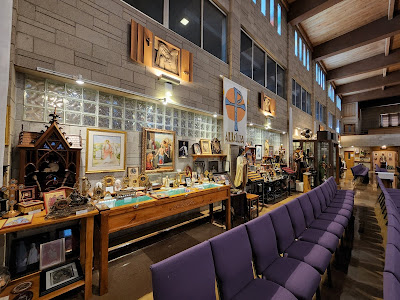St. Anthony's Chapel (Pittsburgh, PA)
No mentioning of relics in America would be completed without mentioning St. Anthony's Chapel located in Pittsburgh, PA. With between 4,000 - 5,000 relics on display, it is the largest collection of relics in the world outside of the Vatican. The chapel features the relics in beautiful reliquaries and features inspiring and deeply moving life-sized Stations of the Cross. On the side altar dedicated to St. Anthony, you will find a 1st class relic of him. In 1880, Father Mollinger founded the chapel. Father Mollinger made several trips to Europe in the subsequent years to collect an unprecedented amount of relics that he saved from desecration during the anti-Catholic conflicts of that time in Germany and Italy.
Shrine of All Saints (Morton Grove, IL)
The Shrine of All Saints is a true treasure in Chicago known to far too few Catholics. The Shrine is located within St. Martha Catholic Church in Morton Grove. St. Martha's main church was originally built as a multi-purpose auditorium and gymnasium for the parish school. But despite this architectural sore spot, the shrine is a treasure. Unassuming from the outside, inside you will find the 2nd largest collection of relics in the United States!
There are over 3,000 relics housed here for public veneration. Some of the relics housed in this shrine were rescued from closed convents in France and saved from relegation to museums and private homes. Others were rescued from estate sales in Italy where families would sell off the relics of their closed private chapels since few families still have personal chaplains.
For more photos and a list of some of the many relics here, click here.
St. John Cantius (Chicago, IL)
While not on permanent display, St. John Cantius Church in Chicago, IL has an amazing collection of relics that are displayed throughout the year. On All Saints Day (and the Octave that follows), they adorn the side altars throughout the church. And relics for individual saints are always exposed for veneration throughout the year in connection with the Stational Churches of Lent. And if you visit on Holy Thursday or Good Friday, you will find the relics of the Passion of our Lord including a relic of the True Cross on display. Those are pictured above. Year-round, you will find a relic of St. Padre Pio here.
Conclusion
Many Catholic churches throughout the country have relics of various saints. Ask your priest whose relics are in the high altar of your church and if the parish has any other relics that can be displayed for public veneration.
Make it a point to look for Catholic shrines in your area. For instance, those near Philadelphia may be surprised to learn of a large collection of relics in honor of St. John Neumann. And those in Chicago also have a large collection of relics at the National Shrine of St. Maximilian Kolbe in Marytown, IL. In Chicago, very few Catholics are aware that a local parish has on display the forearm of St. Jude the Apostle. What relics are you unaware of in your own area?
Finally, if you are not familiar with the honoring of relics, take some time to familiarize yourself with the practice of honoring relics which stretches back to Biblical times. And mark your calendars to honor in a special way the relics in your local parishes and shrines each year on November 5th, the Feast of the Sacred Relics.


































